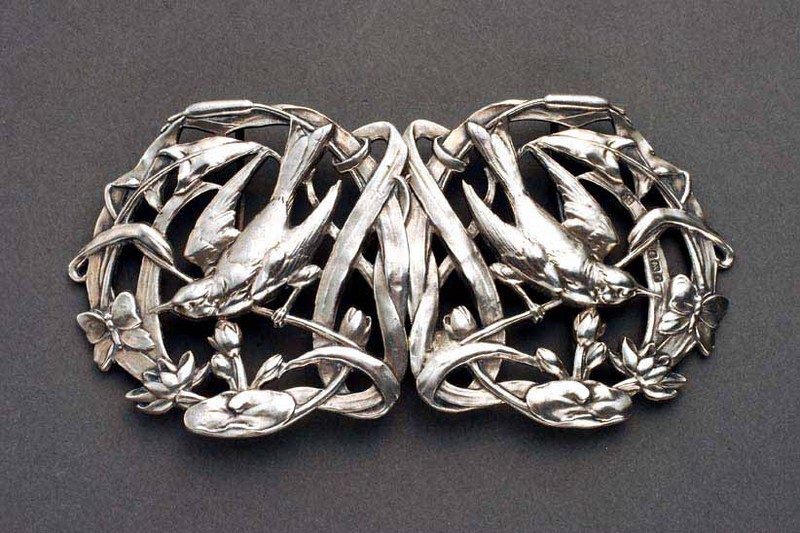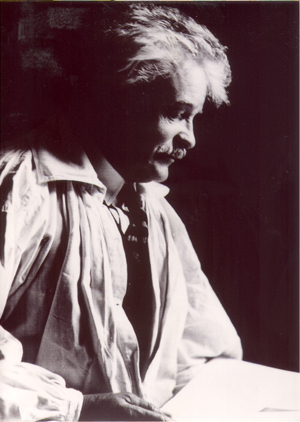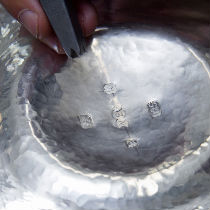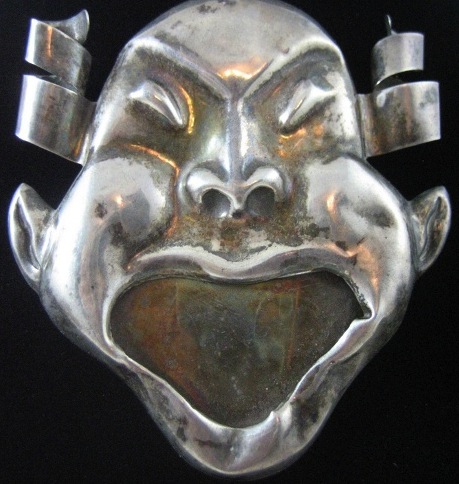Rococo
The rococo is now generally regarded as one of Frances most original and delightful contributions to the Arts. It is hard to believe the antagonism it provoked in contemporary critics. By the early 1720s the first hint of Rococo could be seen in England. It was a complete change to anything that had gone before and silversmiths adopted the style with great enthusiasm as the decoration was so fantastical compared to the plain elegant style that preceded it. The change was mainly one of emphasis in decoration rather than in form. The swirling movement of water is one of the main elements of the rococo, along with masks, and naturalistic floral displays. The shell was a common motif with its frilly fluted edges and crusty surface texture perfectly suited the aim of Rococo ornamentation. By the 1760s the style had lost its sculptural quality and the work was in danger of becoming quite crude.
Neoclassical
The waning interest in Rococo meant that this style became very popular in the second half of the 18th century and saw classical decoration based on Ancient Greece and Rome come into fashion. At this time no wealthy young Englishman’s education was complete without spending at least a year on a tour of the continent and the archeological excavations of Pompeii and Herculaneum in the 1750s made the ancient world very immediate, also revealing a wealth of domestic styles that greatly influenced all aspects of contemporary fashion. Swags, urns, wreaths, rams heads, Greek key borders and drop ring handles were in frequent use in silver although often large areas were left unadorned so that the reflective surfaces emphasized the elegance of the shapes and the grace of the proportions. Silversmiths were quick to realize that the classic fluted stone column made an ideal shaft for a candlestick and despite small variations on the theme this style remains very popular today. Subtle but significant changes in the 1790s meant that the neoclassical style gave way to plainer decoration as the century reached its close.
Regency
Strictly speaking, this style lasted from 1811 to 1820 when the affairs of the country were in the hands of Prince Regent (later George IV ). Not only did he become patron of many silversmiths of the time but also his keen interest in antique styles helped to develop the designs of domestic silverware. The term is often used to include silver pieces from the late 1790s to 1830s. It describes pieces that are often similar to the earlier Neo-Classical style yet are inclined to be pompous and heavy. The style is often characterized by applied gadroon (rope-twist) borders, with added shells, and floral motifs. Sometimes Egyptian motifs are apparent reflecting the interest at the time of these ancient styles and excessive details.
Victorian
There was more silverware made in the 19th Century than ever before or after, the middle classes had a new found wealth and the British Empire was at its height. The Industrial revolution was transforming the old craft trades and innovations by plate manufacturers meant great competition for the traditional silversmiths who were still making by hand. The 18th century passion for antiquarianism continued into the early Victorian era, stimulating a revival of several historic styles that all flourished simultaneously. Naturalism was added to the rococo, gothic, neoclassical etc. styles that were popular and could be seen in abundance at the Great Exhibitions. Towards the end of the century there came about the Arts and Crafts movement as a reaction against the stylized and mass produced articles now typical of the period.
Naturalistic
At the beginning of the 1800s experimental work from London influenced the world. The use of nature in neoclassical decoration now lost its symmetry and formality. Natural forms were not only used as decoration but also took over the whole structure. This is a predominant feature especially between 1825-1850 and at the Great Exhibition of 1851 naturalism ran riot through the English Section. Botanical interest was very high at this time and developments in travel introduced exotic plants and flowers this was also the time when landscape gardens were very popular for pleasure and social functions and this enthusiasm is reflected in the ornamentation of silver.
Gothic
This style can be characterized by a boldness of form and echoes of medieval architecture, such as spires, pointed arches and cast figures. It enjoyed a limited vogue and was mostly confined to ecclesiastical silver although it was used in moderation on domestic pieces.
Arts & Crafts
The Arts and crafts movement came into being with the founding of the Art Workers Guild in 1884, followed by the Arts and Crafts exhibition society four years later. It was not only an aesthetic movement but also a social one; expressing the widespread dissatisfaction with the quality of mass produced items. An admiration for folk art and for the old guilds of medieval craftsmen was also apparent. Large silver manufacturing companies realized that a precious metal and mass production did not really work well together so they turned to artists and designers for guidance. The principle beliefs of the Arts and Crafts movement was that items should always be what they seemed, no jugs disguised as castle turrets etc, the decoration should enhance the silver piece not conceal it, silver should never be made to do something out of character. The hand hammered finish used by silversmiths is one of the main characteristics of this style. The silversmiths encouraged the inequalities of surfaces and as a result the pieces catch the eye in a way the precision and symmetry of machine made objects do not. Its ideas were started by John Ruskin and given expression by William Morris, the movement also influenced workers such as Charles Robert Ashbee. Ashbee believed that good design and craftsmanship could not come out of mechanical and industrial organizations. This could be said about silversmithing as the use of machinery was by no means essential. He put his ideas into practice in 1887 when he founded the School and Guild of Handicraft, shapes were kept as simple as possible.
Aesthetic
Characterized by oriental style engraving and applied decoration. Often incorporating bamboo, birds of paradise, cranes, butterflies, and stylized fan-work. Was at its height during the 1860’s through the 1880’s, but became over-elaborate and was left behind by major interest in the cleaner lines of the Arts & Crafts movement.
Art Nouveau
This style was first introduced to England circa 1890, and was a product of the Arts and Crafts movement started by William Morris et al and the pre – Raphaelites. It was a revolt against the mass produced wares of the Victorian era and was adapted to silverware showing free flowing lines, often asymmetrical, with intertwining floral patterns, insects and female faces depicting a great influence from Japanese Art. The main characteristic seen in most Art Nouveau silver pieces is a long line with a quick curve at the end this has been said to be reflective of the social mood of the time. Eventually it was its own extravagance that led to its demise.
Art Deco
A style that became popular in the late 1920s and early 1930s, it was a movement against the naturalistic feel of the Art Nouveau designs. Art Deco drew together various elements, such as structured floral motifs, stylized curves, geometric shapes and abstract patterns. These ideas ran simultaneously with the cubist movement in fine Art and similarities of the bold graphic shapes are obvious.
Modernism
In the 1950s there came about a complete change in style. Post-war Britain had a renewed interest in form, with the emphasis on sleek modern shapes. Form did not necessarily have to follow function, form was the most important factor. The early 1960s saw the Modernist ideal of pure line and form, together with unadorned surfaces challenge the traditional equation of high style. The admiration for hand made silverware did not blind the new generation of silversmiths against the potentials of mass production, their aim was to balance mechanization and hand finish so that silver was again being put to its best use, as a metal for items of luxury and decoration.











